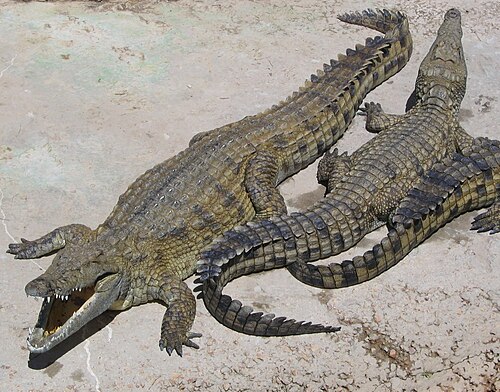Your cart is currently empty!
Mohamed ELBAGOURY

The Nile Crocodile, known scientifically as Crocodylus niloticus, is a large, predatory reptile that inhabits the rivers, lakes, and marshes of sub-Saharan Africa. This species, also known as Timsah Nili in Arabic, plays a vital role in the ecosystem as a top predator and scavenger. In this essay, we will delve into ten key outlines about the Nile Crocodile, exploring its anatomy, behavior, habitat, diet, reproduction, conservation status, cultural significance, and interactions with humans.
1. Anatomy:
The Nile Crocodile is a massive reptile that can grow up to 16 feet in length and weigh over 1,500 pounds. It has a streamlined body, powerful jaws filled with sharp teeth, and a thick, armored skin covered in scales. These physical adaptations make the crocodile a formidable predator capable of taking down large prey such as wildebeest, zebras, and even other predators like lions.
2. Behavior:
Nile Crocodiles are ambush predators that rely on stealth and patience to catch their prey. They often lie in wait near the water’s edge, partially submerged, before lunging out to grab unsuspecting animals that come to drink or swim. Despite their fearsome reputation, crocodiles are surprisingly social animals that engage in complex behaviors such as vocalizations, basking, and courtship displays.
3. Habitat:
Nile Crocodiles are primarily freshwater species that inhabit rivers, lakes, and swamps throughout sub-Saharan Africa. They prefer slow-moving or stagnant water bodies with ample vegetation for cover and basking sites. Crocodiles are also known to travel long distances over land to find new habitats or breeding grounds.
4. Diet:
As opportunistic predators, Nile Crocodiles have a diverse diet that includes fish, birds, mammals, and even other reptiles. They are known to scavenge on carrion and will drag large prey into the water to drown before consuming them. Crocodiles have incredibly strong digestive systems that allow them to digest bones, hooves, and even horns.
5. Reproduction:
Nile Crocodiles are oviparous species, meaning they lay eggs to reproduce. Female crocodiles dig nests in sandy riverbanks or mud pits where they lay a clutch of 25-80 eggs. The mother crocodile will guard the nest and may even help hatchlings emerge from their eggs by gently cracking the shells with her jaws. Once hatched, the baby crocodiles instinctively head to the water, where they are vulnerable to predators like birds and fish.
6. Conservation Status:
Despite being widespread throughout Africa, Nile Crocodiles face threats from habitat loss, pollution, poaching, and illegal hunting. In some regions, crocodiles are killed for their skins, which are highly prized in the luxury leather market. Conservation efforts are underway to protect crocodile populations and their habitats through legislation, habitat restoration, and community education programs.
7. Cultural Significance:
Nile Crocodiles hold cultural significance in many African societies, where they are revered as symbols of power, strength, and resilience. In ancient Egypt, crocodiles were associated with the god Sobek and were mummified and worshipped as sacred animals. Today, crocodiles continue to feature in myths, folklore, and rituals across Africa, symbolizing protection, fertility, and rebirth.
8. Interactions with Humans:
As top predators, Nile Crocodiles occasionally come into conflict with humans when they prey on livestock or pose a threat to people near water bodies. Attacks on humans are rare but can be fatal, especially in areas where crocodiles have lost their natural fear of people. Local communities often struggle to coexist with crocodiles, leading to calls for culls or translocations to manage populations.
In conclusion, the Nile Crocodile is a fascinating and iconic species that plays a crucial role in African ecosystems. By understanding their anatomy, behavior, habitat, diet, reproduction, conservation status, cultural significance, and interactions with humans, we can appreciate the importance of conserving these remarkable reptiles for future generations to enjoy. It is imperative that we find a balance between human activities and wildlife conservation to ensure the survival of species like the Nile Crocodile in their natural habitats.